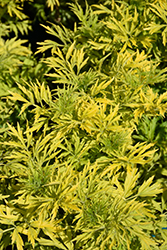Plant Library
Golden Tower Elder
Sambucus nigra 'Jdeboer001'
Height: 10 feet
Spread: 4 feet
Sunlight:
![]()
![]()
Hardiness Zone: 3b
Other Names: Common Elder
Brand: Star
Description:
A bright, colorful shrub, with showy yellow-green foliage that is deeply lobed and fine in appearance; white flower clusters appear in summer; has an elegant, narrow upright growth that is great for screening, shrub borders or containers
Ornamental Features
Golden Tower Elder features showy clusters of fragrant white flowers held atop the branches from early to mid summer, which emerge from distinctive creamy white flower buds. It has attractive gold-variegated yellow foliage with hints of chartreuse which emerges lime green in spring. The serrated compound leaves are highly ornamental but do not develop any appreciable fall colour. The black fruits are held in abundance in spectacular clusters in early fall.
Landscape Attributes
Golden Tower Elder is a multi-stemmed deciduous shrub with a narrowly upright and columnar growth habit. Its relatively fine texture sets it apart from other landscape plants with less refined foliage.
This is a high maintenance shrub that will require regular care and upkeep, and is best pruned in late winter once the threat of extreme cold has passed. It is a good choice for attracting birds to your yard. Gardeners should be aware of the following characteristic(s) that may warrant special consideration;
- Suckering
Golden Tower Elder is recommended for the following landscape applications;
- Accent
- Mass Planting
- Hedges/Screening
- General Garden Use
- Naturalizing And Woodland Gardens
Planting & Growing
Golden Tower Elder will grow to be about 10 feet tall at maturity, with a spread of 4 feet. It has a low canopy with a typical clearance of 1 foot from the ground, and is suitable for planting under power lines. It grows at a fast rate, and under ideal conditions can be expected to live for approximately 30 years.
This shrub does best in full sun to partial shade. It is quite adaptable, prefering to grow in average to wet conditions, and will even tolerate some standing water. It is not particular as to soil type or pH. It is highly tolerant of urban pollution and will even thrive in inner city environments. This is a selected variety of a species not originally from North America.


